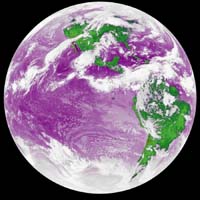| . |  |
. |
 Asteroid Devastation Leads to Ultraviolet Spring
Asteroid Devastation Leads to Ultraviolet Springby David Stauth Corvallis - March 13, 2000 - "By our calculations, the dust cloud would shield the Earth from ultraviolet light for an extended period, with it taking about 390 days after impact before enough dust settled that there would be an ultraviolet level equal to before the impact. After that, the ozone depletion would cause levels of ultraviolet radiation to at least double, about 600 days after impact," said the scientists According to their study, these factors would lead to ultraviolet-related DNA damage about 1,000 times higher than normal, and general ultraviolet damage to plants about 500 times higher than normal. Ultraviolet radiation can cause mutations, cancer, and cataracts. It can kill plants or slow their growth, suppressing the photosynthesis which forms the base of the world's food chain. Smaller asteroid impacts, which have happened far more frequently in Earth's history, theoretically might cause similar or even worse problems with ultraviolet exposure, the researchers say. The ozone depletion would be less, but there would also be less of a protective dust cloud. "Part of what we're trying to stress here is that with an asteroid collision, there will be many synergistic effects on the environment that go far beyond the initial impact," said Cockell, a researcher with the British Antarctic Survey who did some of this analysis while formerly working with NASA. "Effects such as acid rain, fires, the dust clouds, cold temperatures, ozone depletion and ultraviolet radiation could all build upon each other." During the K-T event, the scientists said, many of the animals may actually have been spared most of the ultraviolet spring they envision. That impact, oddly enough, hit a portion of the Earth's crust that was rich in anhydrite rocks. This produced a 12-year sulfate haze that blocked much of the ultraviolet radiation. But it was a lucky shot -- that type of rock covers less than 1 percent of the Earth's surface. So when the next "big one" comes, the scientists said, the ecological repercussions may be more savage than any of those known in Earth's long history. The collision will be devastating, the "impact winter" deadly. But it will be the ultraviolet spring that helps finish off the survivors.
TERRADAILY.COM
|
| |||||||||
| The content herein, unless otherwise known to be public domain, are Copyright 1995-2016 - Space Media Network. All websites are published in Australia and are solely subject to Australian law and governed by Fair Use principals for news reporting and research purposes. AFP, UPI and IANS news wire stories are copyright Agence France-Presse, United Press International and Indo-Asia News Service. ESA news reports are copyright European Space Agency. All NASA sourced material is public domain. Additional copyrights may apply in whole or part to other bona fide parties. Advertising does not imply endorsement, agreement or approval of any opinions, statements or information provided by Space Media Network on any Web page published or hosted by Space Media Network. Privacy Statement All images and articles appearing on Space Media Network have been edited or digitally altered in some way. Any requests to remove copyright material will be acted upon in a timely and appropriate manner. Any attempt to extort money from Space Media Network will be ignored and reported to Australian Law Enforcement Agencies as a potential case of financial fraud involving the use of a telephonic carriage device or postal service. |